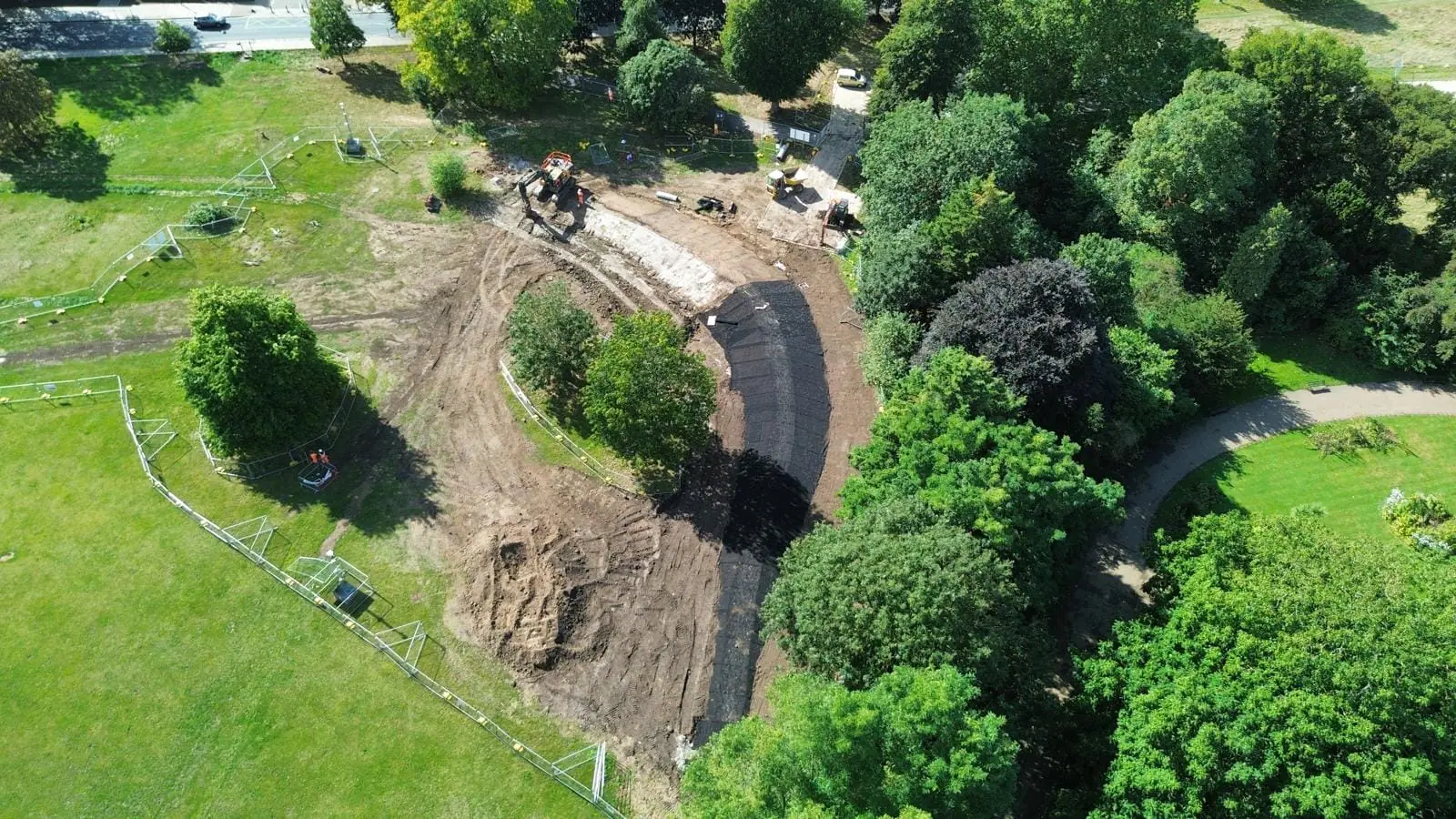Lost Peck: providing flood alleviation for 111 properties in Peckham Rye

In 2016, early engagement began on the “Lost Peck Flood Alleviation Scheme” – with planning permission and an outline business case approved in 2020. The flood alleviation scheme aimed to provide detention storage in Peckham Rye Park & Common, south London. This would protect properties in Peckham Rye from flooding along the “lost” Peck River flow path, which runs through the Common to the north.
Modelling and design calculations showed that this project reduces the risk of surface water flooding to 111 properties in Peckham Rye. The project also minimised the risk to nearby roads and areas of the Common prone to flooding.
The scheme, delivered by Southwark Council (LBS), was costed at £2.1 million, the largest such scheme funded by Environment Agency Grant in Aid in London. Alongside Metis Consultants, other key stakeholders included Thames Water, Volker Stevin Infrastructure Ltd and the Thames Regional Flood and Coast Committee.
The Challenges
Surface water flood risk
111 nearby properties, including a local school, had previously been categorised as being at ‘significant’ risk of surface water flooding. This was due to high-volume surface water runoff along the flowpath of the ‘lost’ River Peck during severe storm events.
The water had flowed through Peckham Rye Park and Common and out onto East Dulwich Road. This exposed those 111 properties to flooding. Thames Water records showed that 16 properties had flooded in recent times, due to sewer surcharge on various streets located immediately to the west of the Park. Underlying London clay geology and a lack of suitable drainage measures exacerbated the issue.
This flooding caused indirect damage such as vehicle impacts (impassable roads and damage), evacuation, emergency accommodation impacts, and mental health impacts, as well as having direct impacts on local residents and businesses.
Reduced use of green spaces
Sections of the Common would become naturally boggy during the winter months. This limited the Common’s potential use for sports and recreation, assessed to be the primary use of the area. Several pathways on the Common were also prone to flooding, limiting the potential for greenery to grow and flourish.
Operating in a built-up area
Attempting a flood alleviation scheme of this scale in a heavily constrained and busy area of London would in itself be a challenge. This was due to higher risk of utility strikes and other disruptions to local infrastructure. Any new features built would also have to blend in with the character of the area, and represent a strong balance between providing effective flood protection and the delivery of wider environmental objectives.
The Solution
Earthworks bunds
Metis has delivered two earthworks bunds (embankments) and associated land drainage. The project completed ground investigations to derive data on soil properties, groundwater levels and permeability. This information helped inform the project on how to effectively manage surface water, ensure the bunds operated efficiently and sustainably and thus optimise flood alleviation. They also help to avoid contamination risks and preserve local ecosystems, by preventing runoff pollution and promoting water reuse.
The scheme underwent a redesign in 2023 to amend the southern bund drainage connection to the Thames Water sewer. This removed the need for widespread tree removal. Consultations with LBS Parks, Trees and Ecology teams guided this redesign forward. This ensured all relevant parties were in complete approval of the updated designs.
A Tree Survey was completed as part of the design. This was in order to understand the Root Protection Areas that would need to be adhered to during construction. An Arboricultural Method Statement was prepared, and regular site visits were conducted by the Arboricultural Consultant during construction to ensure the required measures were being implemented. Following feedback from the LBS Tree Officer, Metis re-designed the originally proposed southern bund. This helped to avoid works in proximity to trees while maintaining storage volume.
Metis designed the bunds at as low a height as possible, whilst maintaining a suitable standard of flood protection. This ensures the features are not too imposing, and blend in with the character of the area.
Landscaping
The scheme delivered landscaping works along the bunds and in the surrounding areas – including to East Dulwich Road. The landscaping used meadowscape “pro-native-enriched-pre-seeded” medium across 2,026 square metres, while also retaining existing trees.
Metis also incorporated native plant species that reflect the local botany and site character, and enhance the biodiversity value of the area. For example, the green space north of East Dulwich Road had currently been in a disused state with overgrown planting. However, proposed landscaping works include the creation of a “natural corridor”. This intends to provide residents with an alternative walking route through this green space, instead of along the Highway footpath.
Sustainability
Metis designed this flood alleviation scheme with a focus on sustainability from the outset – both in the immediate surroundings of Peckham Rye Park and Common, and in the wider area of the Peckham town centre. Metis had a topographic survey, utilities survey, ground investigations and ecological survey carried out to understand the environmental impact of the proposed project – with a focus on existing trees in the area. A programme of tree planting in 2025 will further enhance the arboriculture in the Park and Common.
The project deployed a vacuum excavator in its early stages to preserve surrounding trees, associated roots and wildlife – while also avoiding utility strikes. This enabled the bunds and land drainage to be delivered in areas of dense tree coverage, without impacting existing roots. On two occasions during excavation, using ground-penetrating radar (GPR) revealed that services were shallower than plans and surveys had suggested. This endangered the progress of the project. Initial trial holes and the use of the vacuum excavator ensured that the impacts of this were minimal. In turn, this meant they did not infringe on overall progression of the scheme, which finished ahead of programme.
The Outcome
Metis delivered the Lost Peck flood alleviation scheme on budget, meeting all agreed quality requirements. It conveyed the following benefits:
- 111 properties are now deemed to be in lower flood risk categories
- Surface water run-off rates in the catchment reduced by 97.7% in all storm events (up to and including 1 in 75-year events)
- Drier and more usable recreational sections of the Common
- More accessible entrances, access routes and spaces – providing safer and more pleasant journeys than main road routes
- Promotion of sustainable active travel, including cycling
- Ponding times reduced to less than 24 hours
- Enhanced biodiversity through the creation of new wildlife habitats and plant species
- Greater awareness of the history of the Lost River Peck, thanks to new information boards
- Improved local air quality, due to enhanced buffer planting along East Dulwich Road
The community widely supported the project. Residents understood and appreciated the need for the work, and the benefits that it brings to the local area. Metis also ensured that members of the public had an equal opportunity to contribute to the development of the scheme. This included consulting on various platforms, community workshops and site visits, online consultation, and attendance at community events such as the Peckham Rye fête and letter drops.
Interested in learning more about our work?
Explore some of our other Metis case studies to discover our recent projects.
If you’re seeking an experienced, passionate engineering team to partner with on your next project, contact us today.



